
Parareptilia is a subclass or clade of basal sauropsids (reptiles), typically considered the sister taxon to Eureptilia. Parareptiles first arose near the end of the Carboniferous period and achieved their highest diversity during the Permian period. Several ecological innovations were first accomplished by parareptiles among reptiles. These include the first reptiles to return to marine ecosystems (mesosaurs), the first bipedal reptiles, the first reptiles with advanced hearing systems, and the first large herbivorous reptiles. The only parareptiles to survive into the Triassic period were the procolophonoids, a group of small generalists, omnivores, and herbivores. The largest family of procolophonoids, the procolophonids, rediversified in the Triassic and continued to be successful until their demise in the Triassic-Jurassic mass extinction.
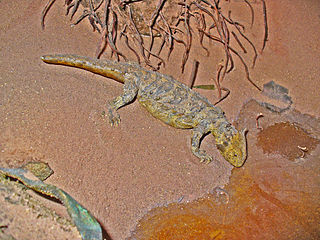
Procolophonidae is an extinct family of parareptiles from the Permian and Triassic periods.
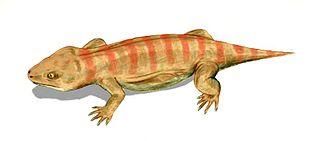
Procolophon is a genus of lizard-like procolophonid reptiles that first appeared in the Late Permian (Lopingian) of South Africa, Brazil, and Antarctica. It persisted through the Permian–Triassic extinction event, but went extinct in the early Triassic. The type species is P. trigoniceps.

Leptopleuron is an extinct genus of procolophonid that lived in the dry lands during the late Triassic in Elgin of northern Scotland and was the first to be included in the clade of Procolophonidae. First described by English paleontologist and biologist Sir Richard Owen, Leptopleuron is derived from two Greek bases, leptos for "slender" and pleuron for "rib," describing it as having slender ribs. The fossil is also known by a second name, Telerpeton, which is derived from the Greek bases tele for "far off" and herpeton for "reptile." In Scotland, Leptopleuron was found specifically in the Lossiemouth Sandstone Formation. The yellow sandstone it was located in was poorly lithified with wind coming from the southwest. The environment is also described to consist of barchan dunes due to the winds, ranging up to 20 m tall that spread during dry phases into flood plains. Procolophonoids such as Leptopleuron were considered an essential addition to the terrestrial ecosystem during the Triassic.

Sclerosaurus is an extinct genus of procolophonid parareptile known from the Early to Middle Triassic of Germany and Switzerland. It contains a single species, Sclerosaurus armatus. It was fairly small about 30 cm long, distinguished from other known parareptiles by the possession of long, backwardly projecting spikes, rear lower jaw teeth with slightly imbricating crowns, and a narrow band of back armor comprising two or three rows of sculptured osteoderms on either side of the midline.
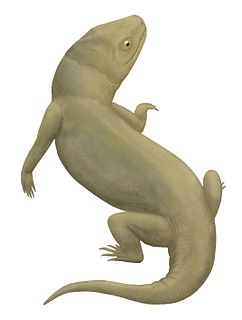
Owenetta is an extinct genus of owenettid procolophonian parareptile. Fossils have been found from the Beaufort Group in the Karoo Basin of South Africa. Although most procolophonians lived during the Triassic, Owenetta existed during the Wuchiapingian and Changhsingian stages of the Late Permian as well as the early Induan stage of the Early Triassic. It is the type genus of the family Owenettidae, and can be distinguished from other related taxa in that the posterior portion of the supratemporal bears a lateral notch and that the pineal foramen is surrounded by a depressed parietal surface on the skull table.
Phonodus is an extinct genus of procolophonid parareptile. It is known from a single skull found from the Early Triassic Katberg Formation in South Africa. It is the oldest known member of the subfamily Leptopleuroninae, and was likely the result of a procolophonid migration into the Karoo Basin from Laurasia after the Permo-Triassic extinction event. Because Phonodus had large maxillary teeth underneath a large antorbital buttress, and a lack of ventral temporal emargination along the side of the skull, it probably had a durophagous diet.

Sauropareion is an extinct genus of basal procolophonid parareptile from earliest Triassic deposits of Eastern Cape Province, South Africa. It is known from the holotype SAM PK-11192, skull and partial postcranium. It was collected by the late L. D. Boonstra in 1935 from Barendskraal in the Middelburg District and referred to the Lystrosaurus Assemblage Zone of the Beaufort Group. It was first named by Sean P. Modesto, Hans-Dieter Sues and Ross J. Damiani in 2001 and the type species is Sauropareion anoplus. The generic name means "lizard", sauros, and "cheek", pareion from Greek in reference to the lizard-like appearance of the temporal region. The specific name comes from the Greek word anoplos, meaning "without arms or armour".
Theledectes is an extinct genus of theledectine procolophonid parareptile from middle Triassic deposits of Free State Province, South Africa.The type species, Theledectes perforatus, is based on the holotype BP/1/4585, a flattened skull. This skull was collected by the South African palaeontologist, James W. Kitching from Hugoskop in the Rouxville District and referred to subzone B of the Cynognathus Assemblage Zone of the Burgersdorp Formation, Beaufort Group. The genus was first named by Sean P. Modesto and Ross J. Damiani in 2003. However, the species was initially assigned to the genus Thelegnathus by C.E. Gow in 1977, as the species Thelegnathus perforatus.
Theledectinae is an extinct subfamily of parareptiles within the family Procolophonidae. Theledectines existed in South Africa, China and Australia during the Early-Middle Triassic period. Theledectinae was named by Juan Carlos Cisneros in 2008 to include the genus Theledectes, and the species "Eumetabolodon" dongshengensis. "E." dongshengensis represents a new genus from China. Cladistically, it is defined as "All taxa more closely related to Theledectes perforatus than to Procolophon trigoniceps Owen, 1876". In 2020, Hamley add the new genus Eomurruna from Australia to this subfamily
Phaanthosaurus is an extinct genus of basal procolophonid parareptile from early Triassic deposits of Nizhnii Novgorod, Russian Federation. It is known from the holotype PIN 1025/1, a mandible. It was collected from Vetluga River, Spasskoe village and referred to the Vokhmian terrestrial horizon of the Vokhma Formation. It was first named by P. K. Chudinov and B. P. Vjushkov in 1956 and the type species is Phaanthosaurus ignatjevi.

Eumetabolodon is an extinct genus of procolophonine procolophonid parareptile from early and middle Triassic deposits of Nei Mongol, northern China. Two species of Eumetabolodon were named by J. L. Li in 1983 and the type species is Eumetabolodon bathycephalus.
Anomoiodon is an extinct genus of procolophonine procolophonid parareptile from early Triassic deposits of Thuringia, Germany. It is known only from the holotype MB.R.3539B and paratype MB.R.3539A, two articulated, three-dimensionally preserved partial skeletons on one block which represent two individuals. The holotype includes nearly complete skull and lower jaw. The block was collected from the lowest layer of the Chirotherium Sandstone Member of the Solling Formation, dating to the early Olenekian faunal stage of the Early Triassic, about 249-247 million years ago. It was first named by Friedrich von Huene in 1939 and the type species is Anomoiodon liliensterni. Laura K. Säilä, who redescribed Anomoiodon in 2008, found it to be a leptopleuronine using a phylogenetic analysis. The most recent analysis, performed by Ruta et al. (2011) found it to be a procolophonine instead. However, both analyses found that it is most closely related to the Russian procolophonid Kapes.

Procolophoninae is an extinct subfamily of procolophonid parareptiles from the late Early Triassic to the early Middle Triassic of Africa, Antarctica, Asia, Europe and South America. Currently, the oldest-known procolophonine is Procolophon from the earliest Olenekian stage.
Lasasaurus is an extinct genus of procolophonid parareptile known from the Early Triassic Middle Sakamena Formation, of northern Madagascar.
Pentaedrusaurus is an extinct genus of procolophonid parareptile from the Early Triassic of China. It is one of the most basal members of the procolophonid subfamily Leptopleuroninae. The only known species of Pentaedrusaurus, P. ordosianus, was named in 1989 from the Heshanggou Formation.
Scoloparia is an extinct genus of procolophonid parareptile from the Triassic of Canada. Fossils have been found in the Early Triassic to Norian-age Wolfville Formation in Nova Scotia, Canada.
Kapes is an extinct genus of procolophonid parareptile from the Lower and Middle Triassic of the United Kingdom and Russia. It is a member of the subfamily Procolophoninae. The type species K. amaenus was named in 1975 from the banks of the Vychegda River in the Komi Republic of Russia. In 1983, a new species was brought into the genus, K. majmesculae. K. majmesculae was first named in 1968 as a member of the genus Tichvinskia. A third Russian species, K. serotinus, was named in 1991. In 2002, Kapes bentoni was named from the Middle Triassic Otter Sandstone Formation of Devon, England, extending the geographic range of Kapes. In the same paper, K. serotinus was synonymized with K. majmesculae and another Russian species was assigned to Kapes called K. komiensis. K. komiensis was first named in 1975 as a member of the genus Macrophon.
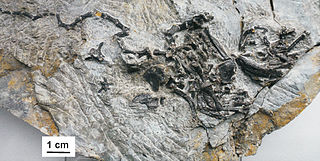
Pappochelys is an extinct genus of diapsid reptile closely related to turtles. The genus contains only one species, Pappochelys rosinae, from the Middle Triassic of Germany, which was named by paleontologists Rainer Schoch and Hans-Dieter Sues in 2015. The discovery of Pappochelys provides strong support for the placement of turtles within Diapsida, a hypothesis that has long been suggested by molecular data, but never previously by the fossil record. It is morphologically intermediate between the definite stem-turtle Odontochelys from the Late Triassic of China and Eunotosaurus, a reptile from the Middle Permian of South Africa.
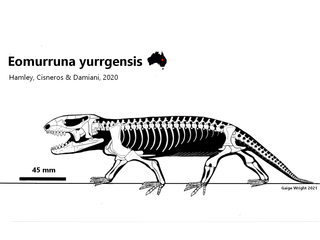
Eomurruna is a genus of procolophonid reptile that existed in what is now Queensland, Australia during the Early Triassic period. The genus is made up of a single species, E. yurrgensis, originally uncovered within the Arcadia Formation in 1985. Since then over 40 specimens have been referred to the genus, making Eomurruna one of the most complete organisms so far found from the Mesozoic of Australia.


















